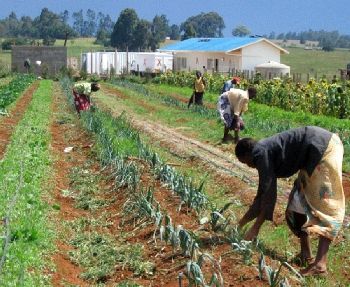
Publisher:
Bonnie King
CONTACT:
Newsroom@Salem-news.com
Advertising:
Adsales@Salem-news.com

~Truth~
~Justice~
~Peace~
TJP
Nov-13-2007 16:25

 TweetFollow @OregonNews
TweetFollow @OregonNews
UN Says Malnutrition Rates in Kenyan Refugee Camps Lowest in Years
Salem-News.com“Real inroads into the scourge of malnutrition are making a genuine difference to young children and their mothers,” - WFP Kenya Country Director Burkard Oberle
 Food production in Kenya Photo courtesy: Purdue University |
(UNITED NATIONS) - Three United Nations agencies today hailed the efforts of the international community in turning around a devastating malnutrition crisis in refugee camps in northern Kenya, adding that continued support was vital to maintain the progress already made.
Thanks to a series of measures taken by the UN refugee agency (UNHCR), the UN World Food Program, malnutrition rates in Dadaab and Kakuma refugee camps are the lowest recorded since 2000.
According to recent surveys, acute malnutrition rates among children under the age of 5 in the three refugee camps at Dadaab have dropped dramatically from 22.2 per cent last year to under 13 per cent. A similar downward trend was seen in the Kakuma camps.
Among the measures taken by the agencies to bring about this change was ensuring a regular supply of culturally acceptable foods, and the provision of energy-saving cooking stoves and soap to ensure that refugees were not compelled to sell a portion of their food to buy these basic items.
But the agencies stressed that continued support was vital if the gains were not to be quickly lost.
“Real inroads into the scourge of malnutrition are making a genuine difference to young children and their mothers,” said WFP Kenya Country Director Burkard Oberle. “It would be criminal to take our foot off the pedal now simply because we can’t afford to keep going. These people need more support, not less.”
The agencies warned that malnutrition levels remain serious, and anaemia rates among children are reaching 81.4 per cent – a slight increase on previous figures. An inter-agency initiative is addressing this through the provision of double-fortified salt in Dadaab and a pilot project supplying micronutrient-rich “sprinkles” in Kakuma.
“These problems are not going away. It is absolutely essential that we are able to maintain a high level of assistance for the refugees, who entirely depend on outside assistance,” said Eddie Gedalof, UNHCR’s Acting Representative in Kenya.
Story continues below
WFP has maintained full food rations in the camps in recent months, ensuring the basic 2,100 kilocalorie daily requirement per refugee and a basic, balanced diet.
Thanks to donor support, supplementary and complementary feeding has been expanded, health facilities are better staffed to fight the constant threat of malaria and other diseases and refugees have a good supply of water.
“Our experience shows that we should not celebrate such short-term success, but redouble our efforts to ensure the work continues to have such a positive impact,” said UNICEF Country Representative in Kenya Olivia Yambi.
The three UN agencies require a combined total of $18 million to continue their operations in Dadaab and Kakuma up to June 2008, assisting some 231,000 refugees, mostly Somali and Sudanese, over 40,000 of whom are children under the age of 5.
Articles for November 12, 2007 | Articles for November 13, 2007 | Articles for November 14, 2007

Quick Links
DINING
Willamette UniversityGoudy Commons Cafe
Dine on the Queen
Willamette Queen Sternwheeler
MUST SEE SALEM
Oregon Capitol ToursCapitol History Gateway
Willamette River Ride
Willamette Queen Sternwheeler
Historic Home Tours:
Deepwood Museum
The Bush House
Gaiety Hollow Garden
AUCTIONS - APPRAISALS
Auction Masters & AppraisalsCONSTRUCTION SERVICES
Roofing and ContractingSheridan, Ore.
ONLINE SHOPPING
Special Occasion DressesAdvertise with Salem-News
Contact:AdSales@Salem-News.com

Salem-News.com:
googlec507860f6901db00.html

Terms of Service | Privacy Policy
All comments and messages are approved by people and self promotional links or unacceptable comments are denied.
[Return to Top]
©2025 Salem-News.com. All opinions expressed in this article are those of the author and do not necessarily reflect those of Salem-News.com.